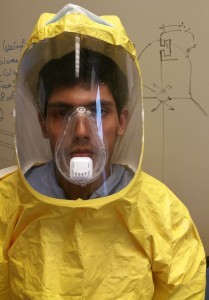The Johns Hopkins University’s has developed a new personal protective suit for front-line health care workers in Ebola. The suit uses technology originally designed by Johns Hopkins to keep cancer patients comfortable. This new suit is color coded to show what surfaces are safe to touch when removing it.
The suit, intended for use in future Ebola outbreaks like the 2014 epidemic that killed thousands in West Africa, has elements to keep the wearer more comfortable than existing suits, reduce the risk of coming in contact with the virus and protect against other infectious diseases.
The bright yellow suit features a large, clear visor that’s integrated into the built-in hood but the color is about more than aesthetics. It’s a major safety feature because the inside of the suit is a distinctly different color to tell the wearer what bits are safe to touch when taking it off.
For doctors, nurses, soldiers, and other responders fighting the Ebola outbreak in West Africa, currently available protective suits are both too hot to wear in the tropics and often a source of contagion when they’re being taken off.
This new design is better than the current garments at keeping health care workers from coming in contact with Ebola patients’ contagious body fluids.
It includes a clear visor incorporated into the suit and air vents in the hood for keeping cool in hot climates, and most ingeniously, a single rear zipper that easily causes the suit to peel away, without the contaminated exterior ever touching the wearer’s skin.
Plastic suits designed to protect health workers against the disease have to be proof against bodily fluids, but they also end up being insufferably hot and damp inside, which means that workers can only wear them for a couple of hours at a time.
Worse, removing the suits without special decontamination suites runs the risk of coming into contact with the very fluids the suit was meant to protect against.
This new anti-contamination suit for health care workers is both cooler to wear and easier to remove to help moving and treating patients safer. The sleeves include fingerless glove liners to make removing the outer gloves easier, and there are tabs on the wrists.
The idea is that pulling the suit off is like a snake shedding its skin. The back pops open, the wearer bends over and steps on the tabs, then stands up as the suit sloughs away.
There are battery-powered air vents in the hood that cools and dehumidifies the incoming air, and the hood has a face mask that directs warm, moist air out as the wearer exhales, so the interior remains dry.
The suit has potential to save the lives of nurses, midwives and other health providers around the globe who are dedicated to delivering quality care, often under challenging circumstances.
For more information please visit: www.jhu.edu

